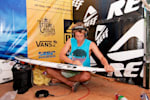If you’re looking for a safe way to get outside during the pandemic, it might be time you learn how to surf. Socially distant by nature, surfing demands a wide berth in the water, which means you can catch waves worry-free. Even better, surfing opens the door to countless future travel experiences, and thanks to adult surf camps, more people of all ages are gravitating toward the sport.
When I decided to learn how to surf last summer, I was drawn to what I perceived as a minimalist sport. Under the impression that all I needed was a board, a beach, and a willingness to learn, I bought a used surfboard on a whim and signed up for a week of lessons at my local beach. But I quickly discovered there was more to surf gear than I had initially thought. From picking the right board to knowing which type of wetsuit to buy, surf gear can get a little complicated—especially for a newbie like myself.
Thankfully, I was able to glean knowledge from seasoned surfers willing to impart their wisdom, and after many blunders and some successes, I’m able to share all that I’ve learned. Below, you’ll find a complete list of everything a rookie surfer needs to get out and enjoy the swell. Read on to discover my picks for the best beginner surf gear, so you can learn how to catch waves, too.
All products featured in this story are independently selected by our editors. However, when you buy something through our retail links, we may earn an affiliate commission.
Surfboard
Rookie surfers will want to forego traditional fiberglass boards in favor of a more forgiving soft top. For this reason, a board like the is beloved by new surfers everywhere. Made of polyethylene foam, the Odysea Log has a buoyancy that beginners will appreciate as they learn to navigate the waves. (I loved practicing on this board at surf camp and found myself wishing I hadn’t been so hasty in buying a lesser-quality surfboard off the Internet.) Start with a longboard—either an 8’ or 9’ is recommended—as the heft of a larger board allows for more speed, making it easier to catch those coveted waves.
Buy now:
Surf leash
Learning how to bail from your board is essential for beginner surfers, but you don’t want to lose your board in the process—which is why you need a surf leash to keep your board tethered to your ankle as you practice paddling, duck diving, and popping up. As a general rule, the size of your leash should be the same or slightly longer than your board. If you’re surfing on an 8’ longboard, the from Dakine is an ideal size. The molded leash is designed to stay tangle-free in the water, while the quarter-inch DuraCord is burly enough to use when you graduate to bigger waves.






Recent Comments